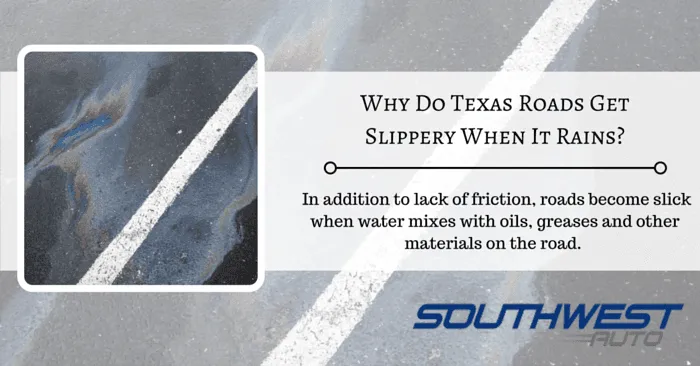You’ve undoubtedly seen the ominous warning signs on Texas roadways: Slippery when wet. If you’re smart, when you see these signs and it’s raining, snowing, drizzling or foggy outside, you automatically reduce your speed and pay closer attention to your driving. But have you ever asked yourself, “ Why do Texas roads get slippery when it rains?” After all, asphalt is a coarse material.
The Science Behind The Slipperiness
The force of rubber tires hitting the tiny pits and grooves that comprise an asphalt roadway creates friction that causes your tires to remain in contact with the road and allows you to maintain good control of the vehicle. When moisture is added to the equation, it fills these pits and makes the road surface smoother. The smoother the surface, the less friction is generated when your tires come in contact with the road. Loss of friction means loss of driver control. In extreme cases, when water completely covers a roadway, a complete lack of friction can occur. This can result in the dangerous phenomenon known as hydroplaning, which causes you to temporarily lose all control of your car. In addition to lack of friction, roads become slick when water mixes with oils, greases and other materials on the road.
Safe Driving Tips For Wet Roads
If you live in Texas, you need to know how to drive in adverse conditions. Here are some tips for staying safe when driving in the rain.
- Make sure your tires are in good working order. At least once a month, check the air pressure in your tires and make sure they are properly inflated. You can find the recommended air pressure on a sticker inside your driver’s side door. Also make sure your tires have sufficient tread (at least 1/16 inch) and take your vehicle in for a tire rotation every 6,000 miles or so to ensure that tread wear occurs evenly over all surfaces.
- Reduce your speed. The slower you drive, the better contact your tires will make with the road. This contact is essential to creating the friction that allows you to maintain control of your car.
- Don’t tailgate. On slick roads, it takes approximately three times longer to come to a stop than it does on dry roads. Try to keep a distance of about two car lengths between your vehicle and the one in front of you
- Be smart. You may have heard the phrase, “Don’t drown, turn around.” So, should you try to drive through a puddle? When in doubt, do not risk it. That puddle could be deeper than you realize.
How To Use Your Brakes Efficiently On Wet Roads
Your tires and brakes are the two most critical vehicle components to keep you safe during wet driving conditions. Even if you’re careful and driving slowly, you may skid. If you do, don’t panic. Don’t slam on your brakes or pump them. Simply apply steady, firm pressure to your brakes and steer toward the skid to avoid losing control. If you hydroplane, don’t brake right away. Remove your foot from the gas, grip the steering wheel and then apply light brake pressure.
One important step to ensure your safety while driving in adverse conditions is to make sure your vehicle is well-maintained. If you’re due for a vehicle checkup or a preventive maintenance service, contact us at Southwest Auto.
 11353 Mathis Avenue Dallas, TX 75229
11353 Mathis Avenue Dallas, TX 75229
